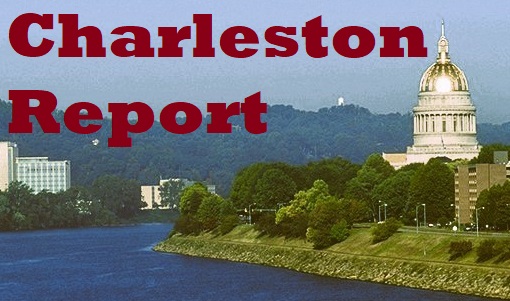January 15th, 2017 by WCBC Radio
Governor Earl Ray Tomblin today delivered his farewell address to the West Virginia Legislature in the House Chamber at the State Capitol Complex after serving six years as governor and a total of 42 years in public service in the Mountain State.
Mr. Speaker, Mr. President, members of the Board of Public Works, justices of the Supreme Court of Appeals, members of the Legislature, distinguished guests, and my fellow West Virginians,
I stand before you today, after six years in the Governor’s office and 42 years in this grand statehouse, with a deep sense of gratitude and reflection and an equally profound hope for West Virginia’s future.
Public service has anchored my life’s work—from a young 22-year-old in this very House chamber, to a desk across the hall in the State Senate, the Senate President’s podium for 17 years and now as your 35th Governor.
It has been the greatest honor—and the greatest reward—to serve the people of this state that we all love. Together, we have put West Virginia first and moved our state forward—even in the midst of tough times, including far-reaching economic shifts, budgetary challenges and historic natural disasters.
West Virginians are strongest in the toughest times. We come together. We lift each other up. And we don’t just hope for a better future; we fight for it.
ECONOMIC DIVERSIFICATION & JOB CREATION
Working hard is exactly what we’ve done over the past six years to create new economic opportunities for the Mountain State.
We have all seen the dramatic impact of the coal industry’s decline in our state. We’ve seen thousands of jobs lost. Families and communities struggling. People beginning to lose hope.
But I believe in—and have fought to reach—the light around the corner.
Shortly after becoming Governor, I pledged to go anywhere and meet with anyone to grow our state’s economy. Across West Virginia, the country and the globe, we have succeeded.
Last year, global giant Procter & Gamble announced it would build its first U.S. manufacturing facility since the 1970s right here in West Virginia in the Eastern Panhandle. This will ultimately be a half-billion dollar investment in the Mountain State and result in hundreds of new jobs.
P&G chose our state after an exhaustive search of many others. And as numerous companies have discovered, I know they will find it to be the best decision they’ve ever made.
Toyota Motor Manufacturing West Virginia, which recently celebrated its 20th anniversary, has expanded continuously—nine times, in fact.
Today, Toyota employs more than 1,600 people. And the company has invested $1.4 billion since 1996.
Manufacturing jobs, like those at P&G in Martinsburg and Toyota in Buffalo, will be among the most critical to our state’s economic future.
In my time as your Governor, I have fought for jobs like these and many more. From Amazon in Huntington and Macy’s in Berkeley County, to Bombardier Aerospace manufacturing in Harrison County—which just in November announced an expansion of 150 jobs.
Companies are finding that when they invest in West Virginia, it pays off.
In fact, since 2011, West Virginia has seen more than $15 billion in new investments, spanning 275 projects. We have welcomed more than 60 new companies and secured 215 competitive expansion projects.
Over the past six years, investment projects have reached 22 industries and provided West Virginians with more than 12,000 good-paying jobs.
Right here in the Kanawha Valley, we have one of the best examples of that remarkable progress.
Gestamp has grown beyond the bounds of any of our expectations. Since opening in 2013, Gestamp has tripled production and more than doubled its workforce, now employing nearly 900 West Virginians.
I know that one of the fundamental reasons behind their growth has been our ability to transform workforce training in West Virginia for the better.
STRENGTHENING WORKFORCE TRAINING & EDUCATION
For example, the Learn and Earn program which we launched in 2012, gives our community and technical college students classroom instruction and hands-on work experience simultaneously. These students earn a competitive salary while giving employers a cost-effective way to recruit and train new employees.
Joe Atha is one of these students. A former coal miner, Joe is now a student at BridgeValley Community and Technical College where he is also supporting his family by earning a wage through the Learn and Earn program at Gestamp.
Joe is here today with his wife, Rita. Please stand to be recognized… along with Dr. Sarah Tucker, Chancellor of our Community and Technical College System.
Through forward-thinking programs like this, we can make a real, lasting difference for West Virginians.
That’s why I personally convened the West Virginia Workforce Planning Council, which has helped us break down bureaucratic silos and better align classroom learning with the workforce needs of our businesses and industries.
We’ve even started that process in high schools through the Simulated Workplace program.
Today, our career technical education classrooms have been transformed into businesses. Medical classes are now clinics. Hospitality programs are now catering businesses and restaurants.
And instead of just going to a welding or carpentry class, our students are now part of a construction company, complete with job foremen and safety inspectors.
Just last month, we celebrated a heartwarming moment as a result of the hard work of more than 2,000 of these students from 12 high schools across the state.
Together with the Department of Education’s Career Technical Education division, the West Virginia National Guard and our Voluntary Organizations Active in Disaster, we presented keys to tiny homes that were designed and built by these students for survivors of the historic floods that hit our state last June.
REBUILDING FROM NATURAL DISASTERS
Time and again, in the aftermath of this tragic flooding we have seen the selflessness of West Virginians make a difference for one another.
The “Big Hearts Give Tiny Homes” project was a shining example of that West Virginia spirit—one that made an overwhelming difference for 15 families impacted by the flooding, including Brenda Rivers from Nicholas County, whose home was a total loss in the flooding. Brenda now lives in a new tiny home built by students, including Chance Ballard from Spring Valley High School in Wayne County.
Please join me in welcoming Brenda and Chance … along with Dr. Kathy D’Antoni … whose visionary leadership at the Department of Education has made Simulated Workplace the success it is today.
Working hand-in-hand with the federal government and local officials, our immediate response to the flooding was quick and effective. We were able to expedite federal assistance to our communities and families in need. And over the past seven months, we have been able to shift our focus to long-term recovery.
Through a public-private approach, we launched the RISE West Virginia program, which in total has provided nearly $2 million to 230 small businesses in the flood-impacted counties—funding that is helping them reopen or continue operations and keep fueling our local economies.
I would like to thank, once again, West Virginia native and champion Brad Smith—the CEO of Intuit, one of the world’s leading financial software companies—and his wife Alys for their family donation of $500,000, which gave the RISE program its first, needed boost.
West Virginia has experienced more than its share of disasters during my time as your Governor—this historic flooding, the Derecho, Hurricane Sandy, Winter Storms Thor and Jonas and the water crisis.
Through it all, we have grown stronger, we have improved our emergency response capabilities and we have strengthened public safety.
Adversity demands resilience. That’s what we have shown in these challenges and many more—including one of the most trying epidemics I believe the Mountain State has ever faced—with the sharp rise in substance abuse and addiction.
FIGHTING SUBSTANCE ABUSE
That’s why in 2011, I issued an Executive Order to create the Governor’s Advisory Council on Substance Abuse, made up of representatives of substance abuse prevention, behavioral medicine, law enforcement, child and adolescent psychology, the legal system, residential treatment facilities, the public school system, the faith community and health care.
My vision for this Council was a community-driven, ground-up approach to tackling this epidemic. Through community-based task forces in six regions across the state, we have made significant progress and enacted life-saving reforms.
We now look at substance abuse as an illness—not a crime.
We have decreased the number of meth labs across the state as the result of making it more difficult to obtain pseudoephedrine.
We have expanded access to the life-saving drug Narcan to first responders and family members of those struggling with addiction. Last year alone, hundreds of lives were saved as a result.
We have substance abuse prevention services in all 55 counties. We have expanded and improved community-based treatment options and recovery services. Across the state, we have 188 crisis detox beds in residential treatment facilities with more sites under development.
We have 118 beds designated for youth and postpartum treatment as well as short-term and long-term residential treatment. And we have over 1,000 beds for those seeking help and support through peer and provider recovery homes and facilities.
We are working closely with our prisons and correctional facilities to ensure all West Virginians are provided access to substance abuse rehabilitation.
In fact, the Division of Corrections operates nine residential substance abuse treatment units in correctional centers across the state and we have expanded this model to our regional jail facilities as well.
And—through Justice Reinvestment—we have successfully worked to address substance abuse, which is the root cause of many crimes.
Because of that work, we have expanded drug courts, substance abuse counseling and greater supervision after release.
And ultimately, we have better controlled incarceration rates, which prevented our state from having to build a new $200 million prison that was projected to be needed because of our previous rising prison population.
Just this week, we announced the news that West Virginia reached settlements with two additional drug wholesalers totaling $36 million, which resolves allegations by our state regarding the distribution of controlled substances in West Virginia.
This brings the total amount of drug settlement money paid to our state by drug wholesalers to $47 million, which will expand our efforts even further for more law enforcement diversion options, more treatment recovery services and many more efforts to fight this epidemic.
I am also deeply proud of the work we have done in creating the state’s first 24-hour substance abuse call line, 844-HELP-4-WV, which has received nearly 8,500 calls since it launched in September 2015.
The help line provides referral support for those seeking help and recovery services. It’s an opportunity for people who are struggling to talk with someone who cares, get connected to treatment options and begin the road to recovery.
No caller is ever placed on hold and they are immediately connected with treatment staff representing the best and most appropriate treatment options for them.
Administered by First Choice Health Systems of West Virginia, the help line is staffed by certified professionals, many who have overcome addiction themselves and want to help others turn their lives around as well.
One young gentleman I met did just that because he picked up the phone.
A.J. Walker, a recovering alcoholic and addict, was given the help line number by his brother.
A.J. said when he called, he was treated like a person—not like a drug addict—and he found hope. They got him into a detox facility and into recovery, and the help line staff called and checked in on him every step of the way.
Today, A.J. is employed by the treatment facility that helped him and he’s in school studying to become a substance abuse counselor.
A.J. is here today with his brother, Andrew, and Vickie Jones … Commissioner of our Bureau of Behavioral Health and Health Facilities.
A.J. we are so proud of you. And today … you are giving hope to so many.
When I hear stories like A.J.’s, I am incredibly optimistic for West Virginia’s future. With economic changes, job losses and families struggling, we have to seize every opportunity before us to become stronger as individuals and as a state.
One such opportunity lies in Boone and Lincoln Counties, where I believe we have the chance to revitalize Southern West Virginia and make the Mountain State stronger.
EMBRACING THE FUTURE
It was here in this chamber, one year ago during my State of the State Address, where I announced plans for the largest development project in West Virginia’s history at the former Hobet surface mine site.
Since last year at this time, we have worked every day and we have made tremendous progress on this project, which is now known as Rock Creek Development Park.
We have worked with local landowners, who are generously donating land that will result in more than 12,000 developable acres for Rock Creek, which is the size of the city of Huntington.
The West Virginia National Guard—Rock Creek’s first tenant—is on the ground with newly-expanded operations for maintenance work and training.
And we have a long-term strategic plan now in place, which looks at demographics and market trends to help us identify the best investment opportunities for Rock Creek.
For generations, our coal miners, workers and their families have kept West Virginia strong. Now, it’s our turn to help them.
By realizing the full potential of Rock Creek Development Park for job creation and economic diversification, we can build up a region of our state hard hit by the downturn in the coal industry.
My vision for Rock Creek started many years ago as I rode my four-wheeler around the hills of Southern West Virginia and saw the possibilities that such an enormous site—with such a great amount of flat land—could have.
Embracing opportunities like this takes careful thought and planning, and this public-private project will require some investment by the state. But I believe wholeheartedly that the returns will vastly exceed our investment.
That isn’t something I say lightly.
Throughout my 42 years in public service, fiscal responsibility has been at the heart of every project I’ve undertaken, every policy I’ve fought for and every decision I’ve made.
GOVERNING RESPONSIBLY
As a result of much hard work, over the years we have decreased taxes, embraced responsible spending, made great progress toward paying off the state’s unfunded liabilities and controlled growth of the state’s budget.
We have realized milestone tax reforms, including progressive elimination of the food tax, saving West Virginians $162 million each year.
We have gradually eliminated the state’s business franchise tax and decreased the corporate net income tax—changes that make West Virginia more attractive for business investments.
As a result of responsible reforms, last year the National Council on Compensation Insurance filed the 12th reduction in workers’ compensation premiums in 12 years. And West Virginia employers have seen a savings of more than $352 million since we privatized the program in 2006.
We addressed our Other Post Employment Benefits by dedicating $30 million annually to pay off the $5 billion unfunded liability, which was caused by previous promises that became too expensive to maintain.
As I did last year, I present to you today a budget that is balanced, but a budget that requires difficult decisions and thinking about the next generation rather than the next election.
I continue to be proud of the fiscal responsibility we have shown not just for the past six years, but over the last generation. Our commitment to paying down our long-term liabilities has not wavered and we have responsibly reduced taxes on both our employers and our employees.
Because of our improved fiscal policies, we have been able to refinance bonds that pay for schools, water and sewer lines, college campus improvements and roads to save more than $100 million in the past six years.
So when people ask me why I’m so concerned with maintaining our Rainy Day Fund and our bond rating, that’s why. It means more schools, more roads and more homes with clean water.
As part of tough decisions during tough economic times, we have cut more than $600 million from our budget in the past five years. While we all continue to hope that the coal industry will rebound, that hasn’t happened quickly and it likely won’t ever return to the levels that we once saw.
We continue to work to diversify our economy and I know the improvements we’ve made will pay long-term dividends in job growth and investment.
But we’re not there yet, and part of being fiscally responsible means making sure that we can pay our bills without taking the Rainy Day Fund to dangerously low levels or cutting services to the point where we cannot care for our people or educate our students.
Therefore, the budget I present to you today includes a 1 percent increase in the consumer sales tax to raise $200 million and elimination of the current sales tax exemption on telecommunications services—a move that would make our system the same as 80 percent of the country.
I understand these taxes will not be easy, but asking people to pay a few dollars more now is a far better choice than seeing PEIA cards not accepted by medical providers or going back to the days when we couldn’t finance school and road improvements, or even pay the gas bill at the Governor’s Mansion.
I urge you to consider these responsible actions to balance the budget until the brighter economic picture that we all expect comes into focus.
CLOSING
I believe the thing that compelled each of us to public service is our love for West Virginia. And that is the very thing that should compel us to work together.
When I became your Governor, I said that we must put West Virginia first.
That’s what we have done. And I encourage you to continue working together out of that deep devotion to our beloved state—in the coming year and beyond.
I am proud of the work that we have accomplished. I look forward to the leadership of Governor-elect Jim Justice and I thank all of you who have worked with me over the years.
I thank my cabinet members and agency directors. And I thank my dedicated staff members who have worked every day—not for me, but for the people of West Virginia.
It has been the honor of my life to be your Governor—to be West Virginia’s Governor. Joanne and I thank the people of West Virginia for your abiding trust, counsel and support.
And we look forward—with the greatest hope and optimism—to an even stronger West Virginia.
Thank you. God bless you. And God bless the great state of West Virginia.




.jpeg)












